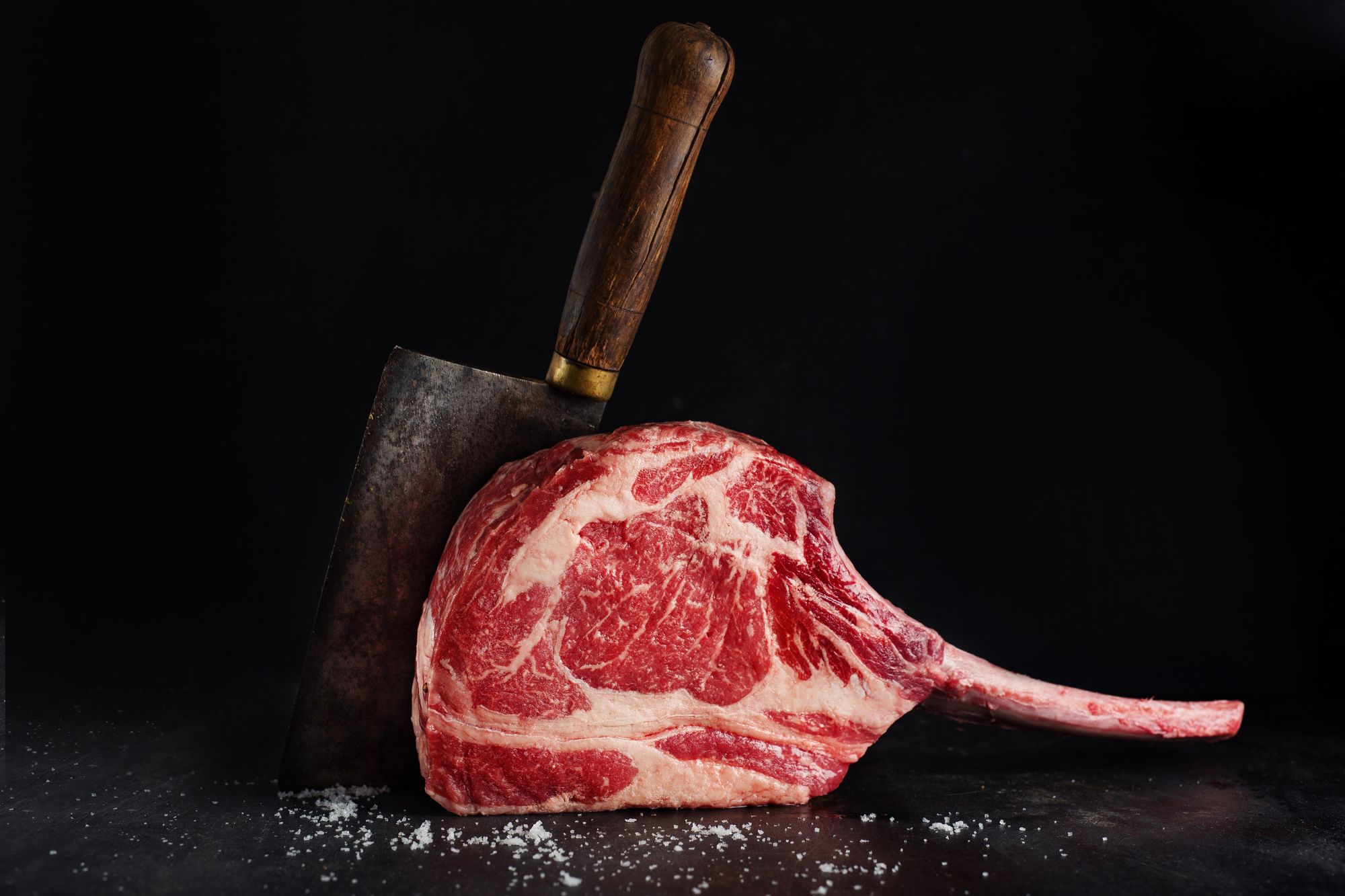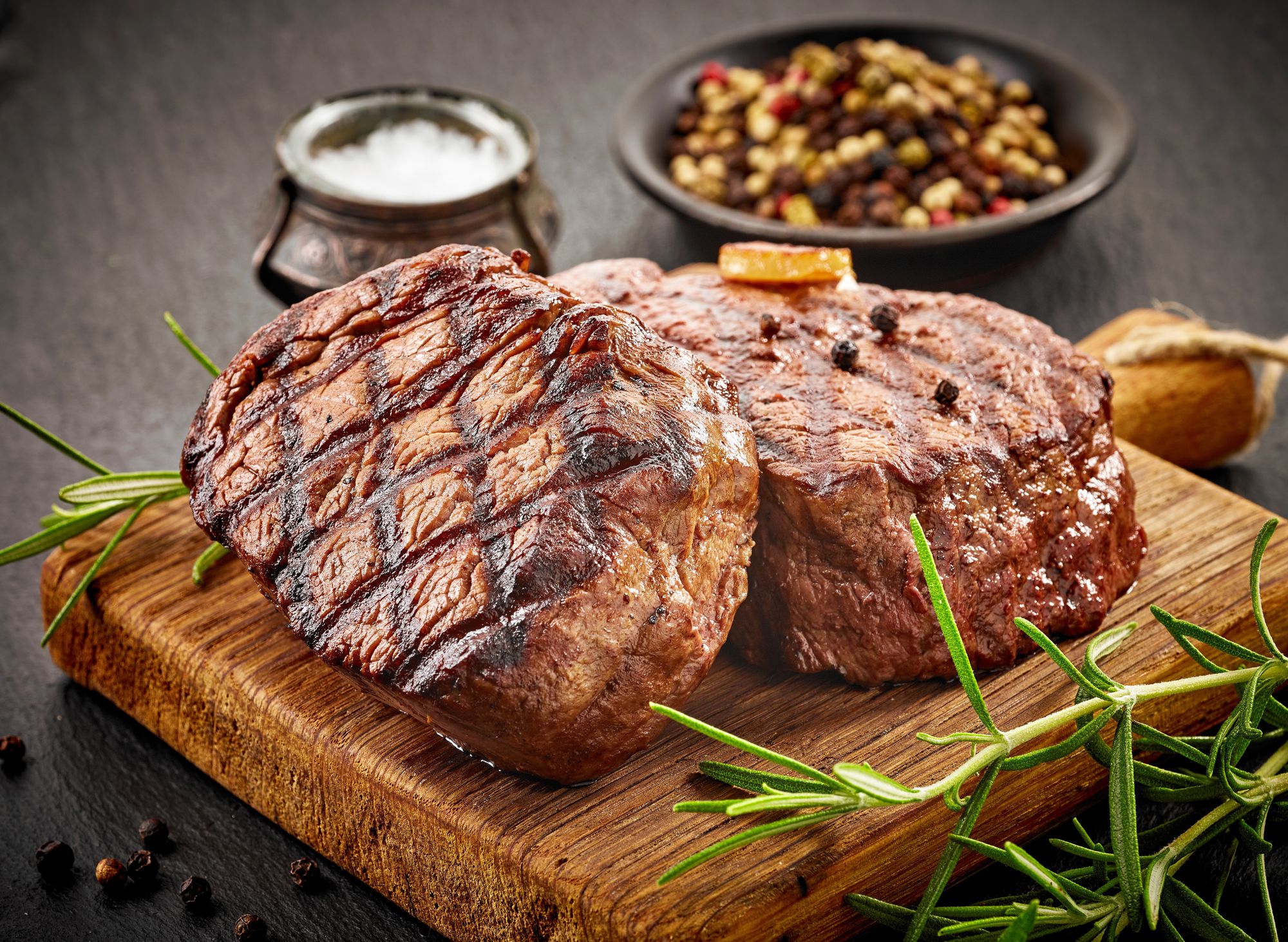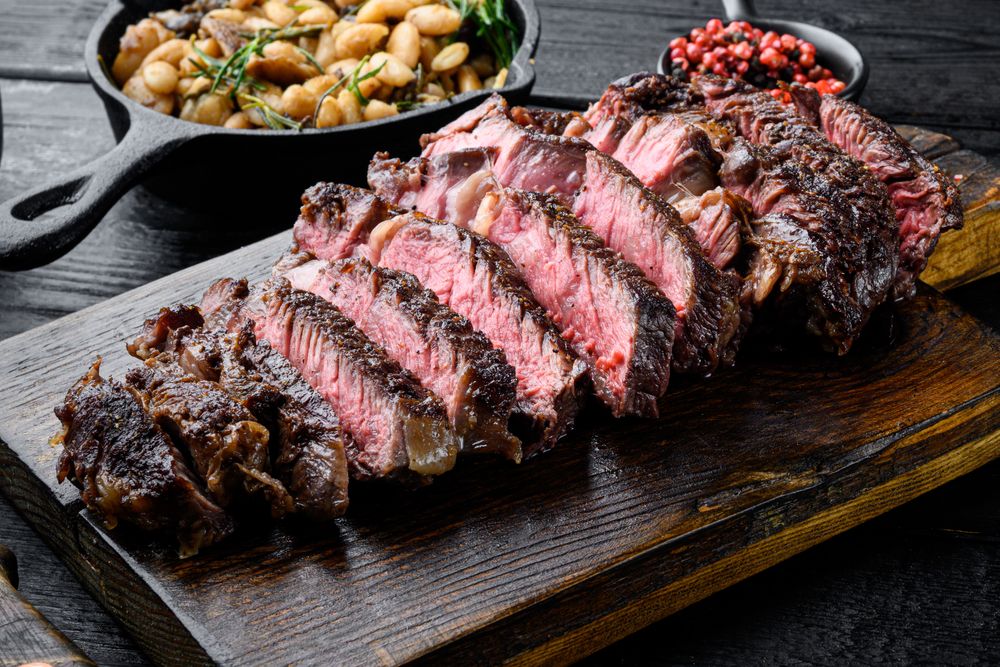Whether you're preparing a flavorful stir-fry with flank steak or indulging in a succulent filet mignon, steak never fails to delight your palate. However, despite its popularity as a meat choice, the debate over the healthiness of steak has divided opinions for years. Some extol the virtues of its nutritional content and essential vitamins, while others argue that its saturated fat levels are too high.
The Nutritional Profiles of Four Common Steak Cuts
"Overall, various steak cuts share similar nutrient levels and provide comparable health advantages or drawbacks, although there is some variability stemming from their distinct origins within the cow. As an illustration, certain cuts may contain higher fat-derived calories or protein content. Below is the nutritional data for four commonly enjoyed steak cuts:"
1) Ribeye (4 ounces):
- Calories: 191
- Protein: 22.6 grams
- Total Fat: 10.6 grams
- Saturated Fat: 4.1 grams
- Carbohydrates: 1.3 grams"
2) Top sirloin (3 ounces):
- Calories: 150
- Protein: 26.2 grams
- Total Fat: 4.3 grams
- Saturated Fat: 1.6 grams
- Carbohydrates: 0 grams
3) Tenderloin (4 ounces):
- Calories: 271
- Protein: 22.4 grams
- Total Fat: 20.2 grams
- Saturated Fat: 8.1 grams
- Carbohydrates: 0 grams"
4) Flank steak (4 ounces):
- Calories: 186
- Protein: 24 grams
- Total Fat: 9.4 grams
- Saturated Fat: 3.9 grams
- Carbohydrates: 0 grams
Even after reviewing the nutritional details, it can remain challenging to assess the overall healthiness of steak and whether you should include it in your diet. As with most things, moderation plays a crucial role, and consulting with your healthcare provider can provide valuable insights to help you make an informed decision about including steak in your regular eating habits.
Continue reading to explore the advantages of consuming steak, along with potential associated side effects. For additional guidance on healthy eating, you can also explore 'What Occurs in Your Body When You Eat Bacon.
What happens to your body when you eat steak?

"Discover Five Advantages of Including Steak in Your Diet."
1) You'll receive a substantial protein intake.
Steak offers a substantial protein content, a crucial nutritional benefit. It plays a significant role in supporting muscle growth and tissue repair," explains Lisa Young, PhD, RDN. "It's richness in protein aids in promoting a feeling of fullness, regulating appetite, and mitigating the risk of overindulgence.
Furthermore, steak is classified as a complete protein, encompassing all nine essential amino acids that the body cannot synthesize independently. In contrast, numerous plant-based proteins are incomplete, lacking these essential amino acids, making steak a valuable protein source that may be absent in certain vegetarian-friendly protein options.
2) You'll come closer to fulfilling your iron needs
In addition to protein, steak can contribute to meeting your daily requirements for essential micronutrients like iron. While iron might not be top of mind for most people unless they are anemic, pregnant, or experience heavy menstrual periods, failing to meet your iron needs through your diet can lead to deficiencies that result in fatigue, muscle weakness, gastrointestinal discomfort, and reduced physical and mental energy.
Iron serves a crucial role in your body by facilitating the production of two vital proteins: hemoglobin and myoglobin. These proteins are responsible for transporting oxygen from your lungs to the rest of your body, as noted by the National Institutes of Health (NIH). Generally, women require more iron than men because menstruating individuals are at a higher risk of iron deficiency due to blood loss. Therefore, the daily recommended intake is 18 milligrams for women aged 19-50 and 8 milligrams for men aged 19-50.
Iron can be obtained from various sources, including animal and plant-based foods such as beef, seafood, poultry, white beans, fortified cereals, lentils, spinach, and nuts. It's worth noting that while plant-based sources provide iron (nonheme iron), it's not as readily absorbed by the body as the heme iron found in animal products. Furthermore, heme iron enhances the absorption of non-heme iron from plant-based foods when consumed together, as explained by Young.
If you include meat in your diet, enjoying steak on occasion can assist you in meeting your iron requirements, as it typically supplies approximately 1-5 milligrams of iron per serving, varying based on the cut. Skirt steak, in particular, tends to offer the highest iron content.
3) You'll make progress toward meeting your daily recommended zinc intake.
You've probably come across the importance of zinc in relation to immunity, and it's well-founded. This micronutrient plays a crucial role in supporting your immune system and metabolism, and fortunately, it's abundant in various foods, including your favorite juicy steak cut. You may have noticed zinc listed in many cold remedies because it can aid your immune system in combatting various illnesses, especially during the pesky cold and flu season. However, if you're simply aiming to meet your daily zinc requirements, steak can be a valuable addition.
The recommended daily intake of zinc is 8 milligrams for women and 11 milligrams for men, and most individuals can reach these recommended levels through their daily dietary choices. Foods like beef, seafood, fortified breakfast cereals, and specific seeds can bring you quite close to the daily value in a single serving, while a serving of oysters can provide nearly 300% of your daily zinc needs!
All cuts of beef contribute to your zinc intake, but if you're intentionally aiming for the highest amount, you'll find over 9 milligrams of zinc in a serving of boneless ribeye. Most other cuts will provide at least 2 or 3 milligrams, which still contributes significantly to meeting your zinc goals.
4) You'll move closer to reaching your daily recommended intake of selenium
Selenium is a vitamin that often doesn't receive as much attention as others, but its importance should not be underestimated. According to the National Institutes of Health, selenium plays a vital role in safeguarding your body against infection and oxidative stress. Additionally, it contributes to reproductive health, DNA production, and the well-being of your thyroid gland.
Steak enthusiasts will be pleased to know that a single serving of this delectable meat can provide you with nearly half of your recommended daily intake of selenium. The recommended daily value (DV) for selenium is 55 micrograms, and you can obtain 28 micrograms from ribeye, 24 micrograms from tenderloin, 26 micrograms from flank steak, and an impressive 33 micrograms from top sirloin.
5) You'll ingest a substantial portion of essential B vitamins.
According to Young, another advantage of indulging in a delicious steak is that in addition to essential nutrients like protein, iron, selenium, and zinc, this red meat is also a rich source of most of the B vitamins that are vital for maintaining optimal brain function and energy metabolism. These B vitamins offer a wide array of health benefits.
Steak boasts nearly the entire spectrum of B vitamins, including thiamin (B1), riboflavin (B2), niacin (B3), B6, folate (B9), and B12. Thiamin is crucial for energy metabolism and growth, riboflavin aids in cell growth and energy production, niacin plays a role in converting food into energy in the body, vitamin B6 is essential for brain health and immunity, folate is necessary for DNA synthesis, and vitamin B12 supports nerve and cell health while also helping to prevent weakness and fatigue. "The presence of vitamin B12 in steak is also essential for DNA synthesis and the production of red blood cells," Young adds.
As evident, steak is a nutrient-dense food that offers your body a wide range of vitamins and minerals. However, it's important to note that steak, like any food, can have potential negative side effects as well.
Three possible adverse outcomes of excessive steak consumption.

Steak is a food rich in nutrients, but there are potential drawbacks to consuming it excessively on a regular basis.
1) Steak includes saturated fat, a dietary component that should be consumed in moderation.
The debate surrounding whether steak (and red meat in general) is beneficial or detrimental to one's health is a topic of extensive discussion. Much of this controversy revolves around the high content of saturated fat found in red meat. According to Young, "There are potential drawbacks to steak consumption, as certain cuts contain elevated levels of saturated fat and cholesterol."
For instance, a serving of steak tenderloin can provide around 8 grams of saturated fat, while the American Heart Association recommends keeping daily intake to approximately 13 grams.
Saturated fat is predominantly found in animal products, and when consumed in moderation, it may not raise significant concerns. However, excessive consumption of saturated fat has been associated with an increased risk of elevated cholesterol levels and coronary heart disease.
Nevertheless, recent research reports have introduced some ambiguity into the saturated fat and heart disease risk relationship. A study published in Current Opinion in Endocrinology, Diabetes and Obesity concluded that saturated fats may not have as substantial an impact on cardiovascular disease and cardiovascular mortality as previously believed.
Because there is a mixed body of evidence regarding the health risks of saturated fat, it's advisable to consult with your healthcare provider to assess your specific dietary needs, especially if you regularly consume steak or other forms of red meat.
2) A potential association between red meat and heart disease exists, but the research findings are inconclusive.
Much like the discussions surrounding saturated fat, the research concerning red meat's relationship with heart disease is also marked by mixed findings. Recent studies conducted within the past couple of years have produced diverse results regarding whether the consumption of red meat is associated with an increased risk of cardiovascular disease.
In a 2022 study published in the American Heart Association's journal Arteriosclerosis, Thrombosis, and Vascular Biology, it was found that a higher intake of red meat was linked to a greater elevation in the risk of cardiovascular disease. The prevailing theory suggests that this connection may be related to the alterations that occur in your digestive tract after consuming red meat. Conversely, researchers in a 2020 study published in the British Medical Journal concluded that consuming red meat was linked to a "modest" rise in coronary heart disease risk and replacing red meat with "high-quality" plant-based foods like legumes, soy, or nuts might help mitigate this risk.
Nonetheless, a study from 2021 published in the American Journal of Clinical Nutrition reached the conclusion that there were no notable associations between unprocessed red meat and heart disease. However, it did establish a link between processed red meat and heart disease, which includes items such as sausages, pepperoni, bacon, and similar products. Furthermore, a previous study featured in the American Journal of Clinical Nutrition found no correlation between red meat consumption and alterations in blood lipid levels or blood pressure, both of which are typical factors contributing to an elevated risk of heart disease.
3) Research indicates a potential link between red meat and cancer.
Regrettably, there appears to be a potential link between the consumption of red meat and an elevated risk of cancer. A 2021 meta-analysis, encompassing 148 research articles and published in the European Journal of Epidemiology, revealed that both processed and unprocessed red meat consumption was associated with an increased risk of specific cancer types. In the case of unprocessed red meats, such as steak, this heightened risk extended to breast cancer, colorectal cancer, colon cancer, lung cancer, endometrial cancer, and rectal cancer.
It's worth noting that the World Health Organization (WHO) has classified red meat as a group 2A carcinogen. According to the WHO, inclusion in this category signifies "limited evidence from epidemiological studies." They further clarify that a "positive association" has been observed, although other factors haven't been entirely ruled out, implying that a definitive causal link between red meat consumption and the heightened cancer risk cannot be guaranteed.

